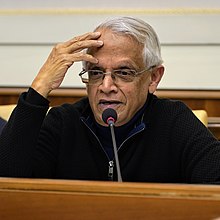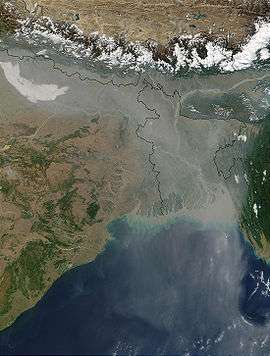Veerabhadran Ramanathan
Veerabhadran Ramanathan (born November 24, 1944) is Edward A. Frieman Endowed Presidential Chair in Climate Sustainability Scripps Institution of Oceanography, University of California, San Diego. He has contributed to many areas of the atmospheric and climate sciences including developments to general circulation models, atmospheric chemistry, and radiative transfer. He has been a part of major projects such as the Indian Ocean Experiment (INDOEX) and the Earth Radiation Budget Experiment (ERBE), and is known for his contributions to the areas of climate physics, Climate Change and atmospheric aerosols research. He is now the Chair of Bending the Curve: Climate Change Solutions education project of University of California. He has received numerous awards, and is a member of the US National Academy of Sciences. He has spoken about the topic of global warming, and written that "the effect of greenhouse gases on global warming is, in my opinion, the most important environmental issue facing the world today."[2]
Veerabhadran Ramanathan | |
|---|---|
 Portrait of Veerabhadran Ramanathan | |
| Born | 24 November 1944[1] Chennai, Madras Presidency, British India |
| Alma mater | Annamalai University IISc Stony Brook |
| Awards | • Buys Ballot Medal • Carl-Gustaf Rossby Research Medal • Tyler Prize for Environmental Achievement • BBVA Foundation Frontiers of Knowledge Award |
| Scientific career | |
| Fields | Atmospheric Scientist |
| Institutions | Scripps Institution of Oceanography |
| Doctoral advisor | Robert Cess |
| Website | ramanathan |
Background and education
Ramanathan was born in Chennai, India. At the age of 11, he moved with his family to Bangalore. The classes at the school he attended were taught in English, and not his native Tamil. He admits that he "lost the habit of listening to my teachers and had to figure out things on my own".[3] He received his BE degree from Annamalai University, and ME degree from the Indian Institute of Science. In 1970, he arrived in the US to study interferometry at the State University of New York at Stony Brook under the direction of Robert Cess. Before Ramanathan could begin working on his PhD research, Cess decided to change his research and focus on planetary atmospheres.
Research and publications

Ramanathan has contributed to many areas of the atmospheric sciences. His first major findings were in the mid-1970s and were related to the greenhouse effect of CFCs and other trace gases[4][5] Until that time, carbon dioxide was thought to be the sole greenhouse gas responsible for global warming. He also contributed to the early development of global circulation models[6] and the detecting and attribution of climate change.[7]
His focus then shifted to the radiative effects of clouds on the climate. This was done using the Earth Radiation Budget Experiment (ERBE), which showed that clouds have a large cooling effect on the planet.[8][9] ERBE was also able to measure the greenhouse effect without the use of climate models.[10]
Recently, he has published on the aerosol radiative properties. His work has shown that aerosols have a cooling effect on the surface of the planet, and at the top of the atmosphere, but the forcing at the top of the atmosphere was only one-third the magnitude as the surface forcing. This has implications for the hydrologic cycle.[11] While working on the Central Equatorial Pacific Experiment, he discovered that absorbing black carbonaceous aerosols have a larger influence on climate than previously thought, which led to the development of the Indian Ocean Experiment (INDOEX).[12] In the 1990s, he led the Indian Ocean Experiment with Paul Crutzen and discovered the widespread existence of atmospheric brown clouds covering much of the Indian Ocean region. They found that the vast majority of the aerosols were anthropogenic in origin, and that the surface cooling caused by the aerosols is more important than the atmospheric heating.[13] These atmospheric brown clouds may have masked as much as 50% of the surface heating caused by the increase in carbon dioxide, and caused reduced precipitation during the Indian monsoon.[14]
Ramanathan is also interested in the impact of climate change on agriculture in India. While atmospheric brown clouds partially offset the warming due from carbon dioxide, their effect on agriculture has been less certain. A statistical rice model couple to a regional climate model has shown that reductions of both carbon dioxide and atmospheric brown clouds will increase crop yield.[15]
He has also written on avoiding dangerous anthropogenic climate change. Ramanathan writes that there are several tipping points in the climate system, and that they do not all occur at the same temperature threshold; the tipping point for the arctic summer sea ice is likely to be smaller than that for the West Antarctic Ice Sheet. While the planet has seen an observed warming of 0.6 °C since pre-industrial times, it has already most likely committed itself to 2.4 °C (1.4 °C to 4.3 °C) of warming. These values surpass several of the tipping point thresholds.[16] In a 2014 paper, Ramanathan and co-authors suggested that mitigating methane, soot, ozone and hydrofluorocarbons in the atmosphere could reduce the expected sea level rise due to climate change.[17]
Project Surya
In March 2007, Ramanathan wrote a white paper with Balakrishnan on a potential project that will reduce air pollution and global warming.[18] Project Surya, which means Sun in Sanskrit, will use inexpensive solar cookers in rural India, and document the reductions in carbon dioxide and soot emissions. The byproducts of biofuel cooking and biomass burning are significant contributors to global warming, and the expanded use of renewable energy is expected to decrease their effects.
The burning of solid fuels causes substantial health risks as well. An estimated 440,000 deaths per year are attributed to unsanitary food preparation techniques due to aerosol exposure.[19] Over 3 billion people cook and heat their home by burning biomass such as wood and feces. The project, costing an estimated $4.5 million, will buy 3,500 cookers and impact up to 15,000 people. As of November 2008, the project has not been funded.[20]
Project Surya was soft launched in March 2009. Each household in the village of Khairatpur, Uttar Pradesh received a biomass cook stoves and a solar lamp. Surya has since received $150,000 in funding from UNEP.[21]
Honors and awards
Ramanathan is an ISI highly cited researcher.[22] He is a fellow of the American Association for the Advancement of Science, American Meteorological Society, American Geophysical Union, and American Academy of Arts and Sciences. In 1995, the Royal Netherlands Academy of Sciences awarded him the Buys Ballot Medal "... for outstanding scientific work in the science of atmosphere over the last decade or two." In 2002, he was awarded the Carl-Gustaf Rossby Research Medal, "... for fundamental insights into the radiative roles of clouds, aerosols and key gases in the Earth's climate system." He was elected a member of the US National Academy of Sciences in 2002 "... for fundamental contributions to our modern understanding of global climate change and human impacts on climate and environment",[23] an Academician of the Pontifical Academy of Sciences in 2004 and a member of the Royal Swedish Academy of Sciences in 2008.[24] Also, Veerabhadran Ramanathan has been bestowed with the BBVA Foundation Frontiers of Knowledge Award 2015 in the Climate Change category for discovering that human-produced gases and pollutants other than CO2 have a huge power to alter the Earth's climate, and that by acting on them it is possible to make a short-term dent on the rate of global warming. He received the prestigious Tang Prize for Sustainable Development in 2018. He was awarded the 90th annual Mendel Medal by Villanova University in 2018 for his work on climate change[25].
Articles
- Why Black Carbon and Ozone Also Matter, in September/October 2009 Foreign Affairs with Veerabhadran Ramanathan and Jessica Seddon Wallack.
- The Climate Threat We Can Beat, in May/June 2012 Foreign Affairs with David G. Victor, Charles F. Kennel, Veerabhadran Ramanathan (website is paid while article is current)[26]
References
- Newton, David E. (2007). Chemistry of the environment. New York: Facts on File. p. 88. ISBN 9781438109749.
- "Global Warming" (PDF). Archived from the original (PDF) on 26 October 2016. Retrieved 10 October 2008.
- Nuzzo, Regina (12 April 2005). "Biography of Veerabhadran Ramanathan". Proceedings of the National Academy of Sciences of the United States of America. 102 (15): 5323–5325. Bibcode:2005PNAS..102.5323N. doi:10.1073/pnas.0501756102. ISSN 0027-8424. PMC 556241. PMID 15811938.
- Ramanathan, V. (1975). "Greenhouse Effect Due to Chlorofluorocarbons: Climatic Implications". Science. 190 (4209): 50–51. Bibcode:1975Sci...190...50R. doi:10.1126/science.190.4209.50.
- Ramanathan, V.; et al. (1985). "Trace Gas Trends and Their Potential Role in Climate Change". J. Geophys. Res. 90 (D3): 5547–5566. Bibcode:1985JGR....90.5547R. doi:10.1029/JD090iD03p05547.
- Ramanathan, V.; et al. (1983). <0605:TROASG>2.0.CO;2 "The Response of a Spectral General Circulation Model to Refinements in Radiative Processes". Journal of the Atmospheric Sciences. 40 (3): 605–630. Bibcode:1983JAtS...40..605R. doi:10.1175/1520-0469(1983)040<0605:TROASG>2.0.CO;2.
- Madden, R.A.; V. Ramanathan (1980). "Detecting Climate Change due to Increasing Carbon Dioxide". Science. 209 (4458): 736–768. Bibcode:1980Sci...209..763M. doi:10.1126/science.209.4458.763. PMID 17753291.
- Ramanathan, V.; et al. (1989). "Cloud-Radiative Forcing and Climate: Results from the Earth Radiation Budget Experiment". Science. 243 (4887): 57–63. Bibcode:1989Sci...243...57R. doi:10.1126/science.243.4887.57. PMID 17780422.
- Ramanathan, V.; et al. (1995). "Warm Pool Heat Budget and Shortwave Cloud Forcing: A Missing Physics?". Science. 267 (5197): 499–503. Bibcode:1995Sci...267..499R. doi:10.1126/science.267.5197.499. PMID 17788784.
- Raval, A.; V. Ramanathan (1989). "Observational determination of the greenhouse effect". Nature. 342 (6251): 758–761. Bibcode:1989Natur.342..758R. doi:10.1038/342758a0.
- Satheesh, S. K.; V. Ramanathan (2000). "Large differences in tropical aerosol forcing at the top of the atmosphere and Earth's surface". Nature. 405 (6782): 60–63. doi:10.1038/35011039. PMID 10811216.
- "INDOEX – The Indian Ocean Experiment". Retrieved 10 October 2008.
- Ramanathan, V.; et al. (2001). "Indian Ocean Experiment: An integrated analysis of the climate forcing and effects of the great Indo-Asian haze" (PDF). J. Geophys. Res. 106 (D22): 28371–28399. Bibcode:2001JGR...10628371R. doi:10.1029/2001JD900133.
- Ramanathan, V.; et al. (2005). "Atmospheric brown clouds: Impacts on South Asian climate and hydrological cycle". Proc. Natl. Acad. Sci. 102 (15): 5326–5333. Bibcode:2005PNAS..102.5326R. doi:10.1073/pnas.0500656102. PMC 552786. PMID 15749818.
- Auffhammer, M.; et al. (2006). "Integrated model shows that atmospheric brown clouds and greenhouse gases have reduced rice harvests in India". Proc. Natl. Acad. Sci. 103 (52): 19668–19672. Bibcode:2006PNAS..10319668A. doi:10.1073/pnas.0609584104. PMC 1693867. PMID 17158795.
- Ramanathan, V.; Y. Feng (2008). "On avoiding dangerous anthropogenic interference with the climate system: Formidable challenges ahead". Proc. Natl. Acad. Sci. 105 (38): 14245–14250. Bibcode:2008PNAS..10514245R. doi:10.1073/pnas.0803838105. PMC 2567151. PMID 18799733.
- Aixue Hu; Yangyang Xu; Claudia Tebaldi; Warren M. Washington; Veerabhadran Ramanathan (2013). "Mitigation of short-lived climate pollutants slows sea-level rise". Nature Climate Change. 3 (8): 730–734. Bibcode:2013NatCC...3..730H. doi:10.1038/nclimate1869.
- "Project Surya: Reduction of Air Pollution and Global Warming by Cooking with Renewable Sources" (PDF). 5 March 2007. Archived from the original (PDF) on 6 July 2008. Retrieved 10 November 2008.
- "New stick to beat developing countries on GHGs". Retrieved 10 November 2008.
- "Climate scientist out to change the world". 11 May 2008. Retrieved 10 November 2008.
- "Project Surya Soft Launch Announcement" (PDF). 9 April 2009.
- "ISI Highly Cited Researchers". Archived from the original on 19 May 2007. Retrieved 10 November 2008.
- "Scientist Elected to National Academy of Sciences". Archived from the original on 24 July 2008. Retrieved 10 October 2008.
- "New members of the Academy". Retrieved 4 May 2009.
- "Villanova University Awards 2018 Mendel Medal to Veerabhadran Ramanathan, PhD, Climate Change Visionary and Pioneer in Climate Science | Villanova University". www1.villanova.edu. Retrieved 20 December 2018.
- UCSD Researchers: Where International Climate Policy Has Failed, Grassroots Efforts Can Succeed; Control of greenhouse agents other than CO2 needs to reach the local level, according to a new Foreign Affairs essay 26 April 2012 University of California, San Diego
External links
| Wikimedia Commons has media related to Veerabhadran Ramanathan. |